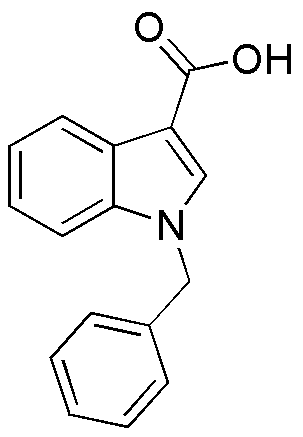1-Benzylindole-3-carboxylic acid is widely utilized in research focused on:
- Pharmaceutical Development: This compound serves as a precursor in the synthesis of various pharmaceuticals, particularly those targeting neurological disorders, due to its ability to interact with specific receptors in the brain.
- Biological Research: It is used in studies investigating the mechanisms of action of indole derivatives, helping researchers understand their potential therapeutic effects and biological activities.
- Material Science: The compound is explored in the development of advanced materials, such as polymers and coatings, owing to its unique chemical structure that enhances material properties.
- Agricultural Chemistry: It finds applications in formulating agrochemicals, where it can act as a bioactive agent, improving crop resilience and pest resistance.
- Analytical Chemistry: This chemical is employed as a standard in analytical methods, aiding in the detection and quantification of similar compounds in complex mixtures.
Informations générales
Propriétés
Sécurité et réglementation
Applications
1-Benzylindole-3-carboxylic acid is widely utilized in research focused on:
- Pharmaceutical Development: This compound serves as a precursor in the synthesis of various pharmaceuticals, particularly those targeting neurological disorders, due to its ability to interact with specific receptors in the brain.
- Biological Research: It is used in studies investigating the mechanisms of action of indole derivatives, helping researchers understand their potential therapeutic effects and biological activities.
- Material Science: The compound is explored in the development of advanced materials, such as polymers and coatings, owing to its unique chemical structure that enhances material properties.
- Agricultural Chemistry: It finds applications in formulating agrochemicals, where it can act as a bioactive agent, improving crop resilience and pest resistance.
- Analytical Chemistry: This chemical is employed as a standard in analytical methods, aiding in the detection and quantification of similar compounds in complex mixtures.
Documents
Fiches de données de sécurité (FDS)
La FDS fournit des informations de sécurité complètes sur la manipulation, le stockage et l’élimination du produit.
Spécifications du produit (PS)
Le PS fournit une description complète des propriétés du produit, notamment sa composition chimique, son état physique, sa pureté et les exigences de stockage. Il détaille également les plages de qualité acceptables et les applications prévues du produit.
Certificats d'analyse (COA)
Recherchez des certificats d'analyse (COA) en saisissant le numéro de lot du produit. Les numéros de lot et de lot se trouvent sur l'étiquette d'un produit, après les mots « Lot » ou « Lot de fabrication ».
Numéro de catalogue
Numéro de lot/série
Certificats d'origine (COO)
Ce certificat d'exploitation confirme le pays dans lequel le produit a été fabriqué, et détaille également les matériaux et composants utilisés et s'il est issu de sources naturelles, synthétiques ou autres sources spécifiques. Ce certificat peut être requis pour les douanes, le commerce et la conformité réglementaire.
Numéro de catalogue
Numéro de lot/série
Fiches de données de sécurité (FDS)
La FDS fournit des informations de sécurité complètes sur la manipulation, le stockage et l’élimination du produit.
DownloadSpécifications du produit (PS)
Le PS fournit une description complète des propriétés du produit, notamment sa composition chimique, son état physique, sa pureté et les exigences de stockage. Il détaille également les plages de qualité acceptables et les applications prévues du produit.
DownloadCertificats d'analyse (COA)
Recherchez des certificats d'analyse (COA) en saisissant le numéro de lot du produit. Les numéros de lot et de lot se trouvent sur l'étiquette d'un produit, après les mots « Lot » ou « Lot de fabrication ».
Numéro de catalogue
Numéro de lot/série
Certificats d'origine (COO)
Ce certificat d'exploitation confirme le pays dans lequel le produit a été fabriqué, et détaille également les matériaux et composants utilisés et s'il est issu de sources naturelles, synthétiques ou autres sources spécifiques. Ce certificat peut être requis pour les douanes, le commerce et la conformité réglementaire.


